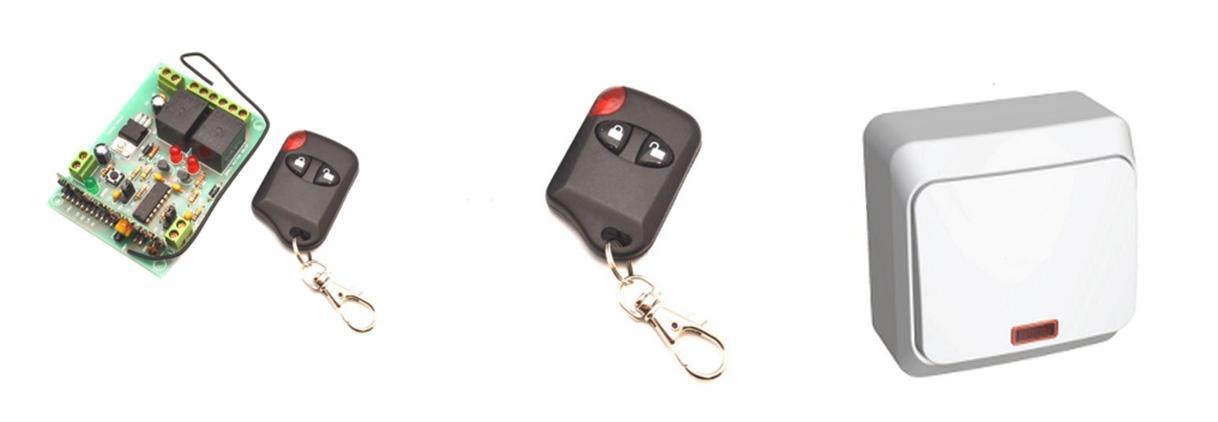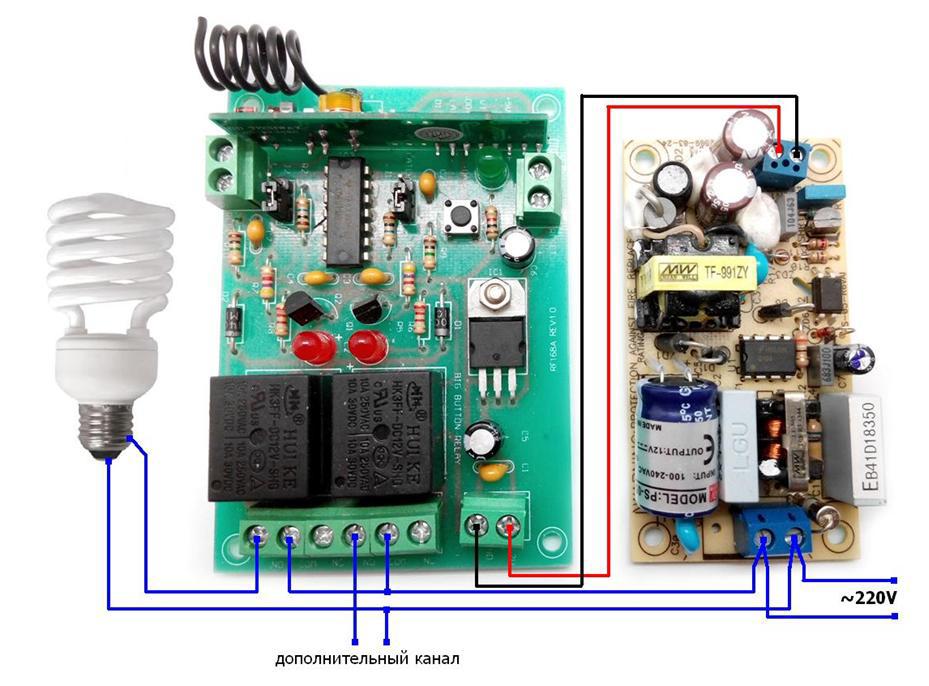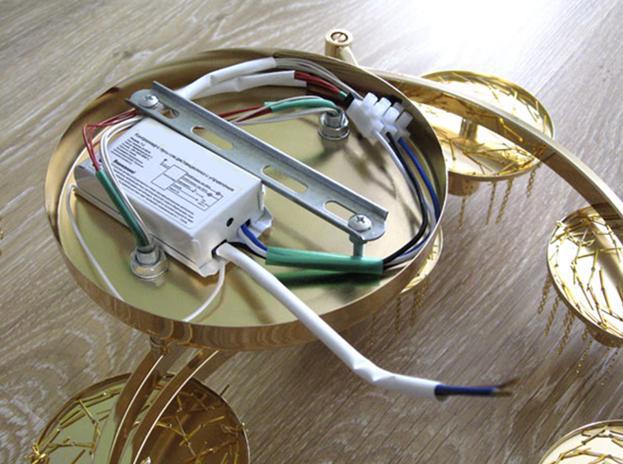Remote control of lighting on standard wiring
Somehow I had to solve the problem of remote control of lighting. The idea was to control the light not only with a switch, but also wirelessly. The difficulty was to connect all this to the standard wiring and save the convenience of control from the standard switch.
A review of such systems has shown that common solutions are applicable only for incandescent lamps, and are in no way suitable for energy-saving lamps. An attempt to adapt them, too, came to naught. After much thought and searching the options, the MP325M system from the Master Keith company was chosen.

To solve our problem we used the following:
')
The MP325M is a dual-channel 433 MHz wireless receiver, and the MP325M / transmitter is an optional dual-channel transmitter in the form of a keychain. As can be seen from the photo, the receiver comes without a housing. The receiver board has a button for adding / removing keyfobs and three LEDs. Green LED informs about pressing buttons on the remote. Two red LEDs report the ON / OFF relay status. Two power relays have the ability to control loads with an operating voltage of 250 V and power up to 2000 watts. Relays have two modes of operation: “Button” and “Trigger”. We will need a trigger mode. It is powered by a 12 V receiver.
The transmitter comes in a plastic case and is equipped with a quick-detachable carabiner for easy mounting, for example, on a bunch of car keys or an entrance door. On the transmitter case there is an indicator of pressing buttons, which can be used to determine whether the battery should be replaced. The transmitter works from the widely used 12 V type 27A battery and maintains its operation up to a voltage of 6 V.
The range of the kit in line of sight is 100 meters, which is enough for home use. The transmitter communicates with the receiver using a digital signal having 1048576 code combinations, which is guaranteed to exclude false alarms from interference and other transmitters at a given frequency. Included get two transmitters. This is very opportunely, since to solve our problem they need just two.
As a power source of the receiver, you can use any adapter with a voltage of 12 V. But I decided to take this seriously so that after a couple of months I don’t understand why the light does not turn on. A quality power source is the key to reliable operation of the entire system. Therefore, it was acquired PW1245.
This source has excellent characteristics:
The source does not require soldering to connect - it has terminals for a screwdriver, which is convenient when mounted on a ladder.
What we do
Firstly, it is desirable to de-energize the part of the circuit where we will make the modification. First of all, we take out the standard switch, and we connect two standard wires to each other, isolating them with PVC tape (if there is space, you can use a terminal block).

Then we take one of the transmitters and disassemble it. In parallel, one of the control buttons solder two pieces of wire. The resulting pins are cleaned and connected to the switch contacts.

If desired, the transmitter shawl itself can also be wrapped with one layer of electrical tape (or in another way). Then go to the point of connection of the lamp or chandelier. We connect the modules according to the scheme below.

If the apartment has a suspended ceiling, the modules can be hidden in the space between the ceilings. If this is not possible, then you can try to install them in the niche of the connection ceiling by pre-insulating the receiver module and power supply with an insulating tape.

Well, that's all you can use.
Now you can independently control the lighting from the switch and the remote control. If the switch stops working after a couple of years, do not panic, just replace the transmitter battery. You can power the receiver from elements 27A or 23A, which are freely sold. The second channel can be used to turn on additional lighting, for example, the effect of a starry sky.

You can also use both channels of the MP325M module. But this will require a two-button switch without latching. And the switch itself may have to be improved by disconnecting the common bus to enable the connection of the second button of the MP325 / transmitter. If necessary, a free relay can be used to control the receiver by connecting the COM and NC contacts in parallel with the reset / add button for remote controls.
Of course, each of us has our own housing conditions, needs and opportunities. Perhaps our solution to someone wants to adapt it specifically for their needs, add additional features or offer their own version. To this we happily say: well! Write! We are always happy to interesting ideas and ready to translate them into reality!
A review of such systems has shown that common solutions are applicable only for incandescent lamps, and are in no way suitable for energy-saving lamps. An attempt to adapt them, too, came to naught. After much thought and searching the options, the MP325M system from the Master Keith company was chosen.

To solve our problem we used the following:
')
- Set MP325M ;
- Power supply PW1245 ;
- MP325M / transmitter ;
- One-button switch without fixing (purchased on the construction market).
The MP325M is a dual-channel 433 MHz wireless receiver, and the MP325M / transmitter is an optional dual-channel transmitter in the form of a keychain. As can be seen from the photo, the receiver comes without a housing. The receiver board has a button for adding / removing keyfobs and three LEDs. Green LED informs about pressing buttons on the remote. Two red LEDs report the ON / OFF relay status. Two power relays have the ability to control loads with an operating voltage of 250 V and power up to 2000 watts. Relays have two modes of operation: “Button” and “Trigger”. We will need a trigger mode. It is powered by a 12 V receiver.
The transmitter comes in a plastic case and is equipped with a quick-detachable carabiner for easy mounting, for example, on a bunch of car keys or an entrance door. On the transmitter case there is an indicator of pressing buttons, which can be used to determine whether the battery should be replaced. The transmitter works from the widely used 12 V type 27A battery and maintains its operation up to a voltage of 6 V.
The range of the kit in line of sight is 100 meters, which is enough for home use. The transmitter communicates with the receiver using a digital signal having 1048576 code combinations, which is guaranteed to exclude false alarms from interference and other transmitters at a given frequency. Included get two transmitters. This is very opportunely, since to solve our problem they need just two.
As a power source of the receiver, you can use any adapter with a voltage of 12 V. But I decided to take this seriously so that after a couple of months I don’t understand why the light does not turn on. A quality power source is the key to reliable operation of the entire system. Therefore, it was acquired PW1245.
This source has excellent characteristics:
- Wide input voltage range from 90 to 260 V;
- Starting current limit, soft start;
- Complex of protection: against short circuit, overload, overvoltage, overheating;
- Low leakage current.
The source does not require soldering to connect - it has terminals for a screwdriver, which is convenient when mounted on a ladder.
What we do
Firstly, it is desirable to de-energize the part of the circuit where we will make the modification. First of all, we take out the standard switch, and we connect two standard wires to each other, isolating them with PVC tape (if there is space, you can use a terminal block).

Then we take one of the transmitters and disassemble it. In parallel, one of the control buttons solder two pieces of wire. The resulting pins are cleaned and connected to the switch contacts.

If desired, the transmitter shawl itself can also be wrapped with one layer of electrical tape (or in another way). Then go to the point of connection of the lamp or chandelier. We connect the modules according to the scheme below.

If the apartment has a suspended ceiling, the modules can be hidden in the space between the ceilings. If this is not possible, then you can try to install them in the niche of the connection ceiling by pre-insulating the receiver module and power supply with an insulating tape.

Well, that's all you can use.
Now you can independently control the lighting from the switch and the remote control. If the switch stops working after a couple of years, do not panic, just replace the transmitter battery. You can power the receiver from elements 27A or 23A, which are freely sold. The second channel can be used to turn on additional lighting, for example, the effect of a starry sky.

You can also use both channels of the MP325M module. But this will require a two-button switch without latching. And the switch itself may have to be improved by disconnecting the common bus to enable the connection of the second button of the MP325 / transmitter. If necessary, a free relay can be used to control the receiver by connecting the COM and NC contacts in parallel with the reset / add button for remote controls.
Of course, each of us has our own housing conditions, needs and opportunities. Perhaps our solution to someone wants to adapt it specifically for their needs, add additional features or offer their own version. To this we happily say: well! Write! We are always happy to interesting ideas and ready to translate them into reality!
Source: https://habr.com/ru/post/256839/
All Articles